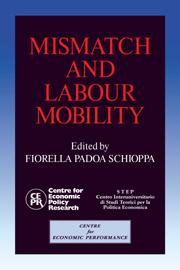Book contents
- Frontmatter
- Contents
- List of figures
- List of tables
- Preface
- Acknowledgements
- List of conference participants
- 1 A cross-country comparison of sectoral mismatch in the 1980s
- 2 Mismatch: a framework for thought
- Discussion
- 3 Match and mismatch on the German labour market
- Discussion
- 4 Mismatch in Japan
- Discussion
- 5 Mismatch and internal migration in Spain, 1962–86
- Discussion
- 6 Regional inequalities, migration and mismatch in Italy, 1960–86
- Discussion
- 7 Skill shortages and structural unemployment in Britain: a (mis)matching approach
- Discussion
- 8 Labour market tightness and the mismatch between demand and supply of less-educated young men in the United States in the 1980s
- Discussion
- 9 Skill mismatch, training systems and equilibrium unemployment: a comparative institutional analysis
- Discussion
- 10 Unemployment, vacancies and labour market programmes: Swedish evidence
- Discussion
- 11 Mismatch and labour mobility: some final remarks
- Index
2 - Mismatch: a framework for thought
Published online by Cambridge University Press: 05 October 2010
- Frontmatter
- Contents
- List of figures
- List of tables
- Preface
- Acknowledgements
- List of conference participants
- 1 A cross-country comparison of sectoral mismatch in the 1980s
- 2 Mismatch: a framework for thought
- Discussion
- 3 Match and mismatch on the German labour market
- Discussion
- 4 Mismatch in Japan
- Discussion
- 5 Mismatch and internal migration in Spain, 1962–86
- Discussion
- 6 Regional inequalities, migration and mismatch in Italy, 1960–86
- Discussion
- 7 Skill shortages and structural unemployment in Britain: a (mis)matching approach
- Discussion
- 8 Labour market tightness and the mismatch between demand and supply of less-educated young men in the United States in the 1980s
- Discussion
- 9 Skill mismatch, training systems and equilibrium unemployment: a comparative institutional analysis
- Discussion
- 10 Unemployment, vacancies and labour market programmes: Swedish evidence
- Discussion
- 11 Mismatch and labour mobility: some final remarks
- Index
Summary
As everybody knows, unemployment rates differ widely between occupations and between regions, as well as across age, race and (sometimes) sex groups. The striking thing is how stable these differences are. In all countries unskilled people have much higher unemployment rates than skilled people. Similarly, youths have higher rates than adults. In addition in most countries (though not the United States) regional differences are highly persistent – with unemployment always above average, for example, in the North of England and the South of Italy.
The first task is to document these differences (in section 1) and then to explain them (in section 2). An obvious question is why occupational and geographical mobility does not eliminate the differences between unemployment rates in different occupations and different regions. We attempt to answer this question. Our main focus is thus on the persistent imbalance between the supply and demand for labour across skill groups, regions and age groups. But there are additional imbalances which are temporary. Suppose, for example, that there are two occupations which have the same average unemployment rate over time but in one year demand shifts from one occupation to the other; this will produce a temporary imbalance until corrected. Such ‘one-off’ structural shocks have aroused great interest in relation to the issue of real business cycles (see Lilien, 1982). They are also clearly of interest to the unemployed themselves. But they account for a fairly small fraction of the inequality among unemployment rates observed in the average year.
Information
- Type
- Chapter
- Information
- Mismatch and Labour Mobility , pp. 44 - 101Publisher: Cambridge University PressPrint publication year: 1991
Accessibility standard: Unknown
Why this information is here
This section outlines the accessibility features of this content - including support for screen readers, full keyboard navigation and high-contrast display options. This may not be relevant for you.Accessibility Information
- 44
- Cited by
